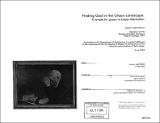| dc.contributor.advisor | Fernando Domeyko. | en_US |
| dc.contributor.author | Marcus, Andrew Todd | en_US |
| dc.contributor.other | Massachusetts Institute of Technology. Dept. of Architecture. | en_US |
| dc.date.accessioned | 2005-09-06T21:30:07Z | |
| dc.date.available | 2005-09-06T21:30:07Z | |
| dc.date.copyright | 2004 | en_US |
| dc.date.issued | 2004 | en_US |
| dc.identifier.uri | http://hdl.handle.net/1721.1/27053 | |
| dc.description | Thesis (M. Arch.)--Massachusetts Institute of Technology, Dept. of Architecture, 2004. | en_US |
| dc.description | Page 83 blank. | en_US |
| dc.description | Includes bibliographical references. | en_US |
| dc.description.abstract | Nature and Gnosticism are problematic terms. With the discovery of a library of so called heretical Gnostic texts in 1945, theologians, historians, and believers the world over have been exposed to Christian texts that call into question the liturgical lineage of the "one holy catholic and apostolic Church" and question the very biblical canon which informs almost all sects of Christianity. The texts in question span religious and cultural boundaries and give us a glimpse of a tradition, more mystical than political, that was lost to mainstream Western history and absorbed into the religions of the East. Understanding the term Nature require a form of extreme self-consciousness, what Peter Fritzell calls "a tolerance for ambiguity that is very difficult to sustain. It is, in essence, a dedication to paradox, and even an occasional delight in uncertainty, that can be extremely unsettling." This thesis proposes is a temple for gnosis in upper Manhattan that creates a space of meditation, reflection, and communion with the knowledge of God employing the theoretical ideas found in the "Gospel of Thomas". The site, located in Inwood Hill Park on the extreme northern end of the island of Manhattan. The park contains true virgin forestland, a salt marsh, Native American cave shelters, and a clandestine and pastoral aspect unknown in the City of New York. An opportunity exists in the lack of ecclesiastical and traditional continuity in the individual relationship to god in the Gnostic gospels, and the ambiguity inherent in the displaced historiography of the texts in question is used as the foundation from which to reform the idea of "church." | en_US |
| dc.description.statementofresponsibility | Andrew Todd Marcus. | en_US |
| dc.format.extent | 83 p. | en_US |
| dc.format.extent | 8122313 bytes | |
| dc.format.extent | 8121560 bytes | |
| dc.format.mimetype | application/pdf | |
| dc.format.mimetype | application/pdf | |
| dc.language.iso | en_US | |
| dc.publisher | Massachusetts Institute of Technology | en_US |
| dc.rights | M.I.T. theses are protected by copyright. They may be viewed from this source for any purpose, but reproduction or distribution in any format is prohibited without written permission. See provided URL for inquiries about permission. | en_US |
| dc.rights.uri | http://dspace.mit.edu/handle/1721.1/7582 | |
| dc.subject | Architecture. | en_US |
| dc.title | Finding God in the urban landscape : a temple for gnosis in upper Manhattan | en_US |
| dc.type | Thesis | en_US |
| dc.description.degree | M.Arch. | en_US |
| dc.contributor.department | Massachusetts Institute of Technology. Department of Architecture | |
| dc.identifier.oclc | 56795959 | en_US |
